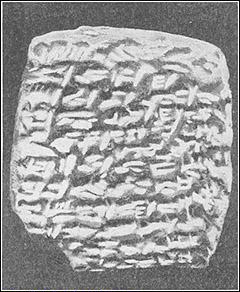An abbreviation is a shortened form of a word or phrase, by any method. It may consist of a group of letters or words taken from the full version of the word or phrase; for example, the word abbreviation can itself be represented by the abbreviation abbr., abbrv., or abbrev.; NPO, for nil per (by) os (mouth) is an abbreviated medical instruction. It may also consist of initials only, a mixture of initials and words, or words or letters representing words in another language. Some types of abbreviations are acronyms or grammatical contractions or crasis.

In music, a note is a symbol denoting a musical sound. In English usage a note is also the sound itself.

The tengwar script is an artificial script created by J. R. R. Tolkien.
The colon: is a punctuation mark consisting of two equally sized dots placed one above the other on the same vertical line. A colon often precedes an explanation, a list, or to introduce a quoted sentence. It is also used between hours and minutes in time, between certain elements in medical journal citations, chapter and verse in Bible citations, and for salutations in business letters and other formal letter writing.
Capitalization or capitalisation is writing a word with its first letter as a capital letter and the remaining letters in lower case, in writing systems with a case distinction. The term also may refer to the choice of the casing applied to text.

An acrostic is a poem in which the first letter of each line spells out a word, message or the alphabet. The word comes from the French acrostiche from post-classical Latin acrostichis, from Koine Greek ἀκροστιχίς, from Ancient Greek ἄκρος "highest, topmost" and στίχος "verse". As a form of constrained writing, an acrostic can be used as a mnemonic device to aid memory retrieval.

In typography, emphasis is the strengthening of words in a text with a font in a different style from the rest of the text, to highlight them. It is the equivalent of prosody stress in speech.

The Amarna letters are an archive, written on clay tablets, primarily consisting of diplomatic correspondence between the Egyptian administration and its representatives in Canaan and Amurru, or neighboring kingdom leaders, during the New Kingdom, between c. 1360–1332 BC. The letters were found in Upper Egypt at el-Amarna, the modern name for the ancient Egyptian capital of Akhetaten, founded by pharaoh Akhenaten (1350s–1330s BC) during the Eighteenth Dynasty of Egypt. The Amarna letters are unusual in Egyptological research, because they are mostly written in a script known as Akkadian cuneiform, the writing system of ancient Mesopotamia, rather than that of ancient Egypt, and the language used has sometimes been characterised as a mixed language, Canaanite-Akkadian. The written correspondence spans a period of at most thirty years.

In typography, all caps refers to text or a font in which all letters are capital letters, for example: TEXT IN ALL CAPS. All caps may be used for emphasis. They are commonly seen in legal documents, the titles on book covers, in advertisements and in newspaper headlines. Short strings of words in capital letters appear bolder and "louder" than mixed case, and this is sometimes referred to as "screaming" or "shouting". All caps can also be used to indicate that a given word is an acronym.
The orthography of the Sotho language is fairly recent and is based on the Latin script, but, like most languages written using the Latin alphabet, it does not use all the letters; as well, several digraphs and trigraphs are used to represent single sounds.
Transformations of text are strategies to perform geometric transformations on text, particularly in systems that do not natively support transformation, such as HTML, seven-segment displays and plain text.
Abbreviations are a common part of the Hebrew language, with many organizations, places, people and concepts known by their abbreviations.
Capitalization or capitalisation in English grammar is the use of a capital letter at the head of a word. English usage varies from capitalization in other languages.

Amarna letter EA 19, is a tall clay tablet letter of 13 paragraphs, in relatively pristine condition, with some minor flaws on the clay, but a complete enough story that some included words can complete the story of the letter. Entitled "Love and Gold", the letter is about gold from Egypt, love between father-king ancestors and the current relationship between the King of Mitanni and the Pharaoh of Misri (Egypt), and marriage of women from King Tushratta of Mitanni to the Pharaoh of Egypt.

The cuneiform MEŠ, or meš is a plural form attached at the end of Mesopotamian cuneiform words as a suffix. As part of a name, or major class being referenced, in capital letters, it is typically separated from other capital letter Sumerograms with a period. The name of the group can follow, in lower case letters, for example:, LÚ.MEŠ–ma-as-sà-meš,.

Amarna letter EA 282, is a relatively short ovate clay tablet Amarna letter, located in the British Museum, no. 29851.

Amarna letter EA 252, titled: Sparing One's Enemies, is a square, mostly flat clay tablet letter written on both sides, and the bottom edge. Each text line was written with a horizontal line scribed below the text line, as well as a vertical left margin-line, scribe line on the obverse of the tablet. The letter contains 14 (15) lines on the obverse, continuing on the bottom tablet edge to conclude at line 31 on the reverse, leaving a small space before the final tablet edge. At least 4 lines from the obverse intrude into the text of the reverse, actually dividing the reverse into a top half and bottom half, and even creating a natural spacing segue to the reverse's text, and the story.

Amarna letter EA 364, titled Justified War, is a clay tablet letter from Ayyab, ruler of Aštartu, to Pharaoh Akhenaten.

Amarna letter EA 367, titled From the Pharaoh to a Vassal, is a medium-small, square clay tablet Amarna letter to Endaruta of Achshaph,, one of only about 10 letters of the el-Amarna corpus, that is from the Pharaoh of Egypt to his correspondent.











